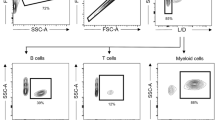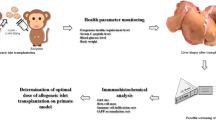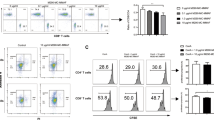Abstract
Cell-based diabetes therapy requires an abundant cell source. Here, we report reversal of diabetes for more than 100 d in cynomolgus macaques after intraportal transplantation of cultured islets from genetically unmodified pigs without Gal-specific antibody manipulation. Immunotherapy with CD25-specific and CD154-specific monoclonal antibodies, FTY720 (or tacrolimus), everolimus and leflunomide suppressed indirect activation of T cells, elicitation of non-Gal pig-specific IgG antibody, intragraft expression of proinflammatory cytokines and invasion of infiltrating mononuclear cells into islets.
This is a preview of subscription content, access via your institution
Access options
Subscribe to this journal
Receive 12 print issues and online access
$209.00 per year
only $17.42 per issue
Buy this article
- Purchase on Springer Link
- Instant access to full article PDF
Prices may be subject to local taxes which are calculated during checkout


Similar content being viewed by others
References
Kuwaki, K. et al. Nat. Med. 11, 29–31 (2005).
Rayat, G.R. et al. J. Endocrinol. 177, 127–135 (2003).
Nyqvist, D. et al. Diabetes 54, 2287–2293 (2005).
Kirchhof, N. et al. Xenotransplantation 11, 396–407 (2004).
Groth, C.G. et al. Lancet 344, 1402–1404 (1994).
Rijkelijkhuizen, J.K. et al. Transplantation 76, 1359–1368 (2003).
Schuler, W. et al. Transplantation 77, 717–726 (2004).
Wijkstrom, M. et al. Transplantation 77, 827–835 (2004).
Rogers, N.J. et al. Nat. Immunol. 1, 163–168 (2000).
Gill, R.G. Transplant. Proc. 24, 642–643 (1992).
Olack, B. et al. J. Immunol. 165, 1294–1299 (2000).
Rayat, G.R. et al. Diabetes 52, 1433–1440 (2003).
Yamada, A. et al. J. Immunol. 167, 5522–5526 (2001).
Manna, S.K. et al. J. Immunol. 165, 5962–5969 (2000).
Hancock, W.W. et al. Transplantation 64, 696–704 (1997).
Acknowledgements
We thank Novartis Pharma AG (Basel, Switzerland) for providing basiliximab, ABI793, FTY720, everolimus and cyclosporine as well as drug-monitoring assays (V. Brinkmann, R. Buergi, G. Engel, F. Legay, W. Schuler); Nippon Kayaku (Tokyo, Japan) for providing 15-deoxyspergualin; E. Rieke and K. Larson for animal care; H.J. Zhang, I. Matsumoto, T. Sawada, B. Liu, L. Guenther, A. Bauer, A. Friberg, J. Kulesa and M. Abdullah for performing porcine islet processing and testing; S. Clemmings, N. Sullivan and K. Hire for assistance with immune monitoring studies; J.S. Arn for facilitating access to miniature swine donors; J. Bendrick-Peart for drug-level determinations; A.C. Gruessner and B.R. Lindgren for statistical analysis of data; M.E. Knatterud for editing the manuscript; and H. Auchincloss, Jr., D.K.C.C. Cooper, J.L. Greenstein and D.H. Sachs for scientific advice. Our study was supported by Immerge BioTherapeutics, Inc., the Eunice L. Dwan Diabetes Research Endowment, the Children with Diabetes Foundation and the Winston and Maxine Wallin Islet Xenotransplant Fund. Immerge BioTherapeutics contributed to the design and conduct of the study; collection, analysis and interpretation of the data as well as preparation of the manuscript.
Author information
Authors and Affiliations
Corresponding author
Ethics declarations
Competing interests
Jane Cheng, Wei Li, Kathleen Moran and Henk-Jan Schuurman were employees of Immerge Biotherapeutics, Inc. at the time of the study.
Supplementary information
Supplementary Fig. 1
Drug exposure. (PDF 140 kb)
Supplementary Fig. 2
Immunopathology of pig-to-nonhuman primate islet xenograft rejection. (PDF 168 kb)
Supplementary Fig. 3
Gal-specific IgM levels. (PDF 66 kb)
Supplementary Fig. 4
Intragraft expression of CTL effector molecule transcripts. (PDF 105 kb)
Supplementary Table 1
Immunosuppressive drugs used and their mechanism of action. (PDF 33 kb)
Supplementary Table 2
Quantitative histopathologic analysis and semiquantitative immunohistochemical characterization of cells infiltrating porcine islet xenografts in immunosuppressed cynomolgus macaques. (PDF 33 kb)
Supplementary Table 3
Adverse events. (PDF 12 kb)
Supplementary Table 4
Non-Gal pig-specific IgG antibodies as detected in a flow cytometry assay. (PDF 18 kb)
Rights and permissions
About this article
Cite this article
Hering, B., Wijkstrom, M., Graham, M. et al. Prolonged diabetes reversal after intraportal xenotransplantation of wild-type porcine islets in immunosuppressed nonhuman primates. Nat Med 12, 301–303 (2006). https://doi.org/10.1038/nm1369
Received:
Accepted:
Published:
Issue Date:
DOI: https://doi.org/10.1038/nm1369
This article is cited by
-
Progress in xenotransplantation: overcoming immune barriers
Nature Reviews Nephrology (2022)
-
Novel Immunomodulatory Approaches for Porcine Islet Xenotransplantation
Current Diabetes Reports (2021)
-
Transplant strategies for type 1 diabetes: whole pancreas, islet and porcine beta cell therapies
Diabetologia (2020)



